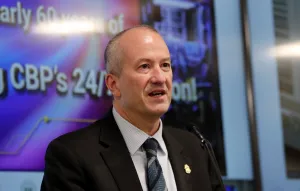U.S. Customs and Border Protection (CBP) made a significant step forward in its information technology systems. At the end of last year, CBP officially shutdown CBP’s Mainframe as a Service, fully retiring CBP’s mainframe environment and transitioning to modern cloud-based systems. This latest move to update the system reduces the time to deliver Information technology (IT) capabilities and provides greater flexibility to meet everchanging CBP mission demands.
"We are here to commemorate a significant leap forward in our agency’s technological capabilities,” said CBP Senior Official Performing the Duties of the Commissioner Troy A. Miller, on Feb. 13, 2024, during an event at CBP’s IT headquarters in suburban Washington, D.C. “For nearly six decades, the mainframe era served us well as a foundation for our operations. But technology and our needs have changed.”
The modernization improves communication and collaboration throughout the agency, delivering information faster to those on the front lines. “Our officers and agents and specialists in the field will have better access to information they need – anywhere anytime,” Miller added. “It makes us more flexible, more efficient which means we can better focus on keeping our nation safe.”
The legacy U.S. Customs Service introduced mainframe technology nearly 60 years ago, making it a federal pioneer in the burgeoning technology sector. The CBP mainframe grew to become one of the largest mainframes in the Federal government, second only to the Social Security Administration. The mainframe processed 3 billion transactions and 1 trillion database requests each month. CBP used it to print tens of thousands of pages of reports and invoices each day. The mainframe supported over 200,000 end-user terminals, printers, and other devices used by CBP, external agencies, and the trade community. In 2019, as an interim step to modernization, CBP replaced the legacy physical mainframe with the cloud-based Mainframe as a Service.
The final step to the mainframe’s retirement was made possible with the rollout of the Automated Commercial Environment Collections Release 7 on Nov. 4, 2023. This allowed CBP to fully retire the final legacy mainframe application, Automated Commercial System, a 35-year-old system comprised of 3.9 million lines of antiquated Common Business-Oriented Language code, still being used to collect over $111 billion annually in taxes, duties, and fees.
“CBP’s IT enterprise transformation involves strategic transformation, tactical operations excellence, and innovation at the speed of CBP’s 24/7 mission,” said CBP Chief Information Officer Sonny Bhagowalia, tipping his hat to all those who worked hard to get to this point. “This historic milestone embodies the incredible teamwork of all the Department of Homeland Security, CBP, and Industry stakeholders over time using business and IT best practices to meet the mission needs faster, better, more securely, and more affordably.”
CBP’s pivot from the mainframe to more modern technology solutions reduces the time to deliver IT capabilities and provides greater flexibility to meet changing mission needs. It provides remote access to data and applications from anywhere with an internet connection, offering greater flexibility.
“We have worked tirelessly and will continue to do so to make this achievement a reality,” Miller said. “With this transition, we are embarking on a new chapter for CBP, one where we are better positioned to perform our mission of protecting the nation’s borders, its citizens and its economy, now and in the future.”



